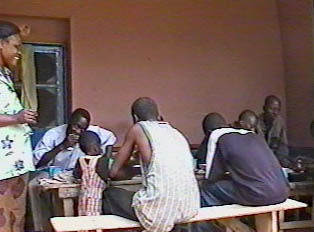LangMedia
Twi in Ghana
Eating at Home

For city-dwelling Ghanaians, a typical breakfast might consist of hot chocolate (referred to as “tea”) and bread with margarine. For those wanting a heavier breakfast, there is a wide range of hot cereals varying in textures and consistency. Most are made from corn, but hot oatmeal is popular as well. Cereal can also be eaten with bread, but then, one would exclude hot chocolate. Occasionally, for a more substantial meal, an egg will be included, but eggs are not typicaly eaten every day since the cost makes high consumption impossible for those with large families. A western breakfast of toast and bacon, cornflakes or eggs is also available. In the country, farmers and laborers often go to work without stopping for breakfast, but return home in the middle of the day to enjoy a substantial lunch.
Lunch is eaten at around noon. In the cities, the meals frequently center around rice cooked with tomato or bean sauce. There is a popular dish called jollof rice consisting of vegetables, rice, beef and a sauce cooked together. Rice can be fried or cooked in such a way as to make it sticky enough to be shaped into balls. Rice balls are then dipped by hand into soups made with peanuts, palm nuts, or a light soup of cooked vegetables. A national favorite is fufu, a combination of boiled cassava and boiled plantain pounded together into soft balls. The process of creating the paste is intricate, and requires one person to pound the boiled vegetables with a very heavy stick while another person turns the paste. The process takes place in a ritualized and rhythmic fashion. Much attention is given to the texture of fufu, with great care taken to make it soft without being runny. Fufu is not chewed, but rather tasted then quickly swallowed.
The bulk of a Ghanaian meal is carbohydrate. When there is animal protein, often it is seafood, particularly crab, due to availability and affordability. Meat is used more in the North where seafood is harder to come by.
In the countryside where families can come home during the day, lunch is usually the main meal. In the cities, where families are more spatially separated by workplace and school, dinner is usually the main meal. Dinner is served at around 7:00, and usually consists of the same dishes that are served at lunchtime in similar quantities.
Sweets are not a large part of Ghanaian cuisine. When something sweet is eaten, it is not with the meal but rather, at some point afterward, as a kind of snack. A favorite sweet is bofrot, flour and water fried in round balls then sprinkled with sugar. Ghana is known for its chocolate, which tends to be less sweet and has a richer chocolate flavor than chocolate from other countries. Ice cream is a favorite treat, but one usually goes out for ice cream, rather than storing it in the house.
Water is the preferred beverage with every meal. Coffee is rare, and Ghanaians sometimes refer to what we call hot chocolate as “tea.” Other times, tea made from teabags with milk and sugar is also popular.
Cooking is done by the women in the house: the mother, daughters and live-in helpers. A live-in helper is often a distant relative who has come from the village to live in the household. While she helps with household tasks, the family will see that she is trained in a vocation such as a cook or a seamstress. The young men in the family take care of other chores such as emptying the garbage and washing the cars.
Videos
-
"Roasting Chickens"Transcript document:
-
"Pounding Fufu"Transcript document:
